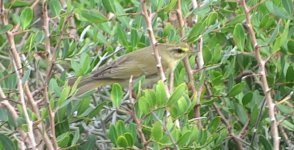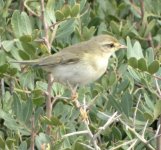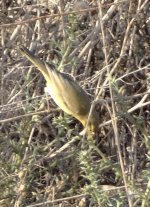Checking the primary projection on a blown up version of the first photo shows a primary projection of 90% (compared to tertial length) which firmly puts Willow Warbler territory (80-100% primary projection). Iberian is usually given as 70% and Common as 60%. However, given individual variation and the problems of accurately measuring this feature from photographs, I remain unconvinced that this feature is always 100% reliable as I'd be surprised if there's not a degree of overlap with some Willow Warblers at the upper end of Iberian's range or, come to that, with some Common Chiffchaffs at the other end of the spectrum. Unfortunately, I've no concrete evidence of this .... does anyone?






